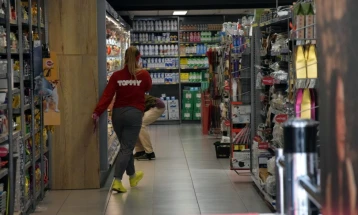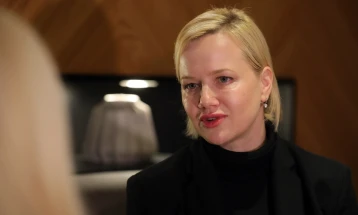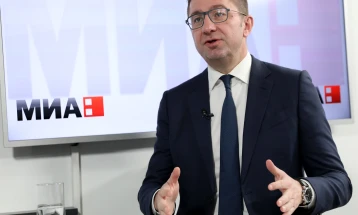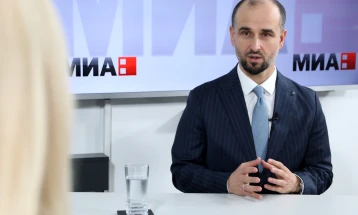Can and will Tetovo’s Ottoman-era fortress be saved from ruination?
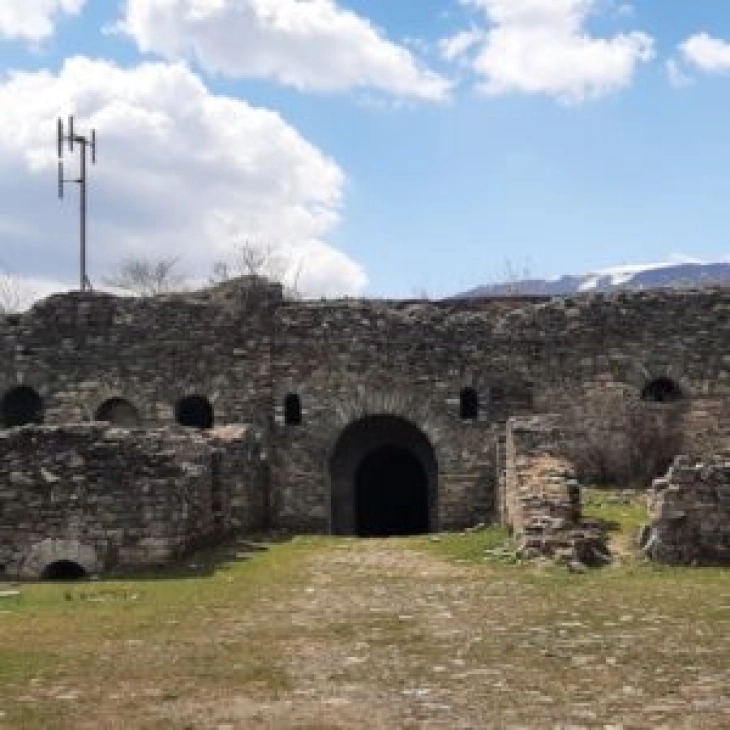
Tetovo, 21 April 2021 (MIA) - The Fortress in Tetovo, built in the Ottoman period on Baltepe Hill, has been abandoned and left in ruins for many years despite being under state protection as an important monument of historical heritage. Only remnants are left of the fortress and inner facilities, primarily of the walls and tunnels.
Only one of the inner buildings, that used to serve as an army dining hall, was restored and conserved, preserving the building’s authentic external appearance. These works were done between 2008 and 2012, and archeological research was also part of the project. One of the walls was also repaired. Over the years, the work would be reduced to certain walls that were in danger of collapsing, and they would intervene by setting up support structures.
The Director of the National Conservation Center, Memet Selmani, says that the institution he is in charge of works in stages, depending on funds they get from the Ministry of Culture. The fourth stage envisaging protection, conservation, restoration and reconstruction of the entrance of the Tetovo Fortress is planned for 2021. 700,000 denars were allocated for this stage.
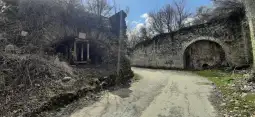 “The main gate collapsed a few years ago. We’re slowly trying to get back to the concept of the existing appearance. The problem with working in fortresses like this one is expensive materials used to glue together the stones used during construction. We had around EUR 5,000 last year (350,000 denars). All of it went to injecting a substance that glues the stones together. Three tons of it cost EUR 5,000. It’s a tri-component material that holds the stones together. The ministry gives us limited funds, so we have to take it slow,” Memet Selmani states.
In accordance with the project they applied to the ministry with, immediate protection and conservation is planned for the military outpost.
“The main gate collapsed a few years ago. We’re slowly trying to get back to the concept of the existing appearance. The problem with working in fortresses like this one is expensive materials used to glue together the stones used during construction. We had around EUR 5,000 last year (350,000 denars). All of it went to injecting a substance that glues the stones together. Three tons of it cost EUR 5,000. It’s a tri-component material that holds the stones together. The ministry gives us limited funds, so we have to take it slow,” Memet Selmani states.
In accordance with the project they applied to the ministry with, immediate protection and conservation is planned for the military outpost.
 “In 2021, we are proceeding with the repairs on the inner ceiling by rebuilding parts of it where stone blocks had come out. We will finish building the front wall by the entrance of the room. Building of the support wall by the road as well as repairing the collapsed wall across the outpost will also be constructed. Immediate protection of outpost 2 will be done afterwards. After grouting the inner ceiling and injecting it from the outside, setting screws between the stone plates, an armed concrete plate was set last year 10 cm over the ceiling to which the screws are bound to, hanging it to prevent it from lowering and making it impossible for it to collapse. Hydro-isolation is placed over the plate, and a stone plate floor. This will prevent the collapse of the ceiling in outpost 2. Then restoration of the fallen parts of outpost 2 and a regrouting will also be done,” the project says.
According to historical data of the Tetovo Region Museum, Recep Pasha started building the Fortress at the end of the 18th century on the peak of Baltepe Hill. It is believed to have had 108 thousand m2 and a rich interior.
“The walls are 3-5 meters thick, reaching up to 10 meters in height, made of caustic stone. Construction took 20 years, and the pasha’s son, Abdurahman finished it, and he lived in the fortress from 1831 until 1843. There were two monumental gates in the fortress, two smaller gates, nine towers, facilities and a kitchen for the army, observation towers and two saray where the pasha would stay,” the Tetovo Region Museum says.
“In 2021, we are proceeding with the repairs on the inner ceiling by rebuilding parts of it where stone blocks had come out. We will finish building the front wall by the entrance of the room. Building of the support wall by the road as well as repairing the collapsed wall across the outpost will also be constructed. Immediate protection of outpost 2 will be done afterwards. After grouting the inner ceiling and injecting it from the outside, setting screws between the stone plates, an armed concrete plate was set last year 10 cm over the ceiling to which the screws are bound to, hanging it to prevent it from lowering and making it impossible for it to collapse. Hydro-isolation is placed over the plate, and a stone plate floor. This will prevent the collapse of the ceiling in outpost 2. Then restoration of the fallen parts of outpost 2 and a regrouting will also be done,” the project says.
According to historical data of the Tetovo Region Museum, Recep Pasha started building the Fortress at the end of the 18th century on the peak of Baltepe Hill. It is believed to have had 108 thousand m2 and a rich interior.
“The walls are 3-5 meters thick, reaching up to 10 meters in height, made of caustic stone. Construction took 20 years, and the pasha’s son, Abdurahman finished it, and he lived in the fortress from 1831 until 1843. There were two monumental gates in the fortress, two smaller gates, nine towers, facilities and a kitchen for the army, observation towers and two saray where the pasha would stay,” the Tetovo Region Museum says.
 Mikjo Stojcheski, director of the Tetovo Region Museum, says that in better times, with a capital project to span over a dozen years, the fortress could be restored to its previous glory.
“If we were to restore all facilities, all the archeological artifacts we’d find would be part of a museum exhibit. In the interest of culture, we could make a cultural center for all sorts of festivals and cultural and art-related events that would elevate the culture, and it would create a tourist attraction and an educational spot for young people,” the Museum director says.
There is an asphalted road leading up to the hilltop and the Fortress, and the place is visited solely by Tetovo residents that use the road to hike up to the peak of Baltepe.
Aleksandar Samardjiev
Translated by Dragana Knezhevikj
Mikjo Stojcheski, director of the Tetovo Region Museum, says that in better times, with a capital project to span over a dozen years, the fortress could be restored to its previous glory.
“If we were to restore all facilities, all the archeological artifacts we’d find would be part of a museum exhibit. In the interest of culture, we could make a cultural center for all sorts of festivals and cultural and art-related events that would elevate the culture, and it would create a tourist attraction and an educational spot for young people,” the Museum director says.
There is an asphalted road leading up to the hilltop and the Fortress, and the place is visited solely by Tetovo residents that use the road to hike up to the peak of Baltepe.
Aleksandar Samardjiev
Translated by Dragana Knezhevikj
 “The main gate collapsed a few years ago. We’re slowly trying to get back to the concept of the existing appearance. The problem with working in fortresses like this one is expensive materials used to glue together the stones used during construction. We had around EUR 5,000 last year (350,000 denars). All of it went to injecting a substance that glues the stones together. Three tons of it cost EUR 5,000. It’s a tri-component material that holds the stones together. The ministry gives us limited funds, so we have to take it slow,” Memet Selmani states.
In accordance with the project they applied to the ministry with, immediate protection and conservation is planned for the military outpost.
“The main gate collapsed a few years ago. We’re slowly trying to get back to the concept of the existing appearance. The problem with working in fortresses like this one is expensive materials used to glue together the stones used during construction. We had around EUR 5,000 last year (350,000 denars). All of it went to injecting a substance that glues the stones together. Three tons of it cost EUR 5,000. It’s a tri-component material that holds the stones together. The ministry gives us limited funds, so we have to take it slow,” Memet Selmani states.
In accordance with the project they applied to the ministry with, immediate protection and conservation is planned for the military outpost.
 “In 2021, we are proceeding with the repairs on the inner ceiling by rebuilding parts of it where stone blocks had come out. We will finish building the front wall by the entrance of the room. Building of the support wall by the road as well as repairing the collapsed wall across the outpost will also be constructed. Immediate protection of outpost 2 will be done afterwards. After grouting the inner ceiling and injecting it from the outside, setting screws between the stone plates, an armed concrete plate was set last year 10 cm over the ceiling to which the screws are bound to, hanging it to prevent it from lowering and making it impossible for it to collapse. Hydro-isolation is placed over the plate, and a stone plate floor. This will prevent the collapse of the ceiling in outpost 2. Then restoration of the fallen parts of outpost 2 and a regrouting will also be done,” the project says.
According to historical data of the Tetovo Region Museum, Recep Pasha started building the Fortress at the end of the 18th century on the peak of Baltepe Hill. It is believed to have had 108 thousand m2 and a rich interior.
“The walls are 3-5 meters thick, reaching up to 10 meters in height, made of caustic stone. Construction took 20 years, and the pasha’s son, Abdurahman finished it, and he lived in the fortress from 1831 until 1843. There were two monumental gates in the fortress, two smaller gates, nine towers, facilities and a kitchen for the army, observation towers and two saray where the pasha would stay,” the Tetovo Region Museum says.
“In 2021, we are proceeding with the repairs on the inner ceiling by rebuilding parts of it where stone blocks had come out. We will finish building the front wall by the entrance of the room. Building of the support wall by the road as well as repairing the collapsed wall across the outpost will also be constructed. Immediate protection of outpost 2 will be done afterwards. After grouting the inner ceiling and injecting it from the outside, setting screws between the stone plates, an armed concrete plate was set last year 10 cm over the ceiling to which the screws are bound to, hanging it to prevent it from lowering and making it impossible for it to collapse. Hydro-isolation is placed over the plate, and a stone plate floor. This will prevent the collapse of the ceiling in outpost 2. Then restoration of the fallen parts of outpost 2 and a regrouting will also be done,” the project says.
According to historical data of the Tetovo Region Museum, Recep Pasha started building the Fortress at the end of the 18th century on the peak of Baltepe Hill. It is believed to have had 108 thousand m2 and a rich interior.
“The walls are 3-5 meters thick, reaching up to 10 meters in height, made of caustic stone. Construction took 20 years, and the pasha’s son, Abdurahman finished it, and he lived in the fortress from 1831 until 1843. There were two monumental gates in the fortress, two smaller gates, nine towers, facilities and a kitchen for the army, observation towers and two saray where the pasha would stay,” the Tetovo Region Museum says.
 Mikjo Stojcheski, director of the Tetovo Region Museum, says that in better times, with a capital project to span over a dozen years, the fortress could be restored to its previous glory.
“If we were to restore all facilities, all the archeological artifacts we’d find would be part of a museum exhibit. In the interest of culture, we could make a cultural center for all sorts of festivals and cultural and art-related events that would elevate the culture, and it would create a tourist attraction and an educational spot for young people,” the Museum director says.
There is an asphalted road leading up to the hilltop and the Fortress, and the place is visited solely by Tetovo residents that use the road to hike up to the peak of Baltepe.
Aleksandar Samardjiev
Translated by Dragana Knezhevikj
Mikjo Stojcheski, director of the Tetovo Region Museum, says that in better times, with a capital project to span over a dozen years, the fortress could be restored to its previous glory.
“If we were to restore all facilities, all the archeological artifacts we’d find would be part of a museum exhibit. In the interest of culture, we could make a cultural center for all sorts of festivals and cultural and art-related events that would elevate the culture, and it would create a tourist attraction and an educational spot for young people,” the Museum director says.
There is an asphalted road leading up to the hilltop and the Fortress, and the place is visited solely by Tetovo residents that use the road to hike up to the peak of Baltepe.
Aleksandar Samardjiev
Translated by Dragana Knezhevikj 